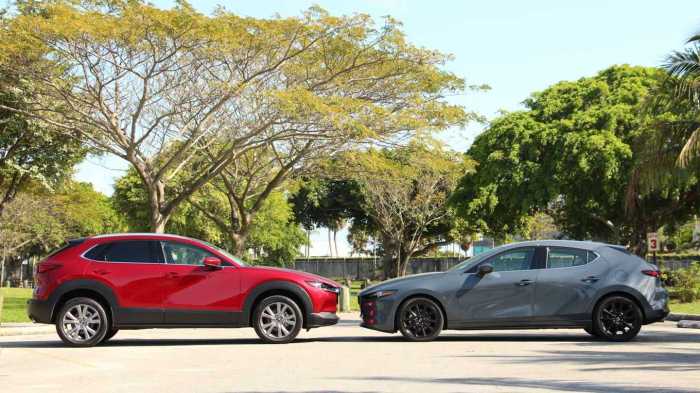Mazda CX-30 vs Mazda 3 Fuel Efficiency
Mazda CX-30 vs Mazda 3 fuel efficiency – Choosing between the Mazda CX-30 and the Mazda 3 often comes down to personal preference – SUV practicality versus sedan sleekness. However, fuel efficiency is a significant factor for many buyers. This comprehensive comparison delves into the intricacies of fuel economy for both vehicles, helping you make an informed decision based on your needs and driving habits. We’ll explore various factors influencing fuel consumption, including engine options, drivetrain, and driving style, providing a detailed analysis to clarify which model offers superior gas mileage.
Engine Options and Their Impact on Fuel Efficiency
Both the Mazda CX-30 and Mazda 3 offer a range of engine choices, each affecting fuel economy differently. Understanding these variations is crucial for accurate comparison. Let’s break down the engine options available for each model:
Mazda CX-30 Engine Options and MPG
- 2.5L Skyactiv-G Inline-4: This naturally aspirated engine is the standard offering for the CX-30. While providing adequate power, its fuel efficiency is a key selling point. Expect combined MPG figures around 28-31 mpg, depending on trim level and driving conditions. This engine provides a good balance of performance and fuel economy for everyday driving.
- 2.5L Skyactiv-G Turbocharged Inline-4 (Premium): This more powerful option offers significantly increased performance but at the cost of slightly reduced fuel economy. While exact figures vary by trim, expect a combined MPG in the lower 20s.
Mazda 3 Engine Options and MPG, Mazda CX-30 vs Mazda 3 fuel efficiency
- 2.5L Skyactiv-G Inline-4: Similar to the CX-30, the Mazda 3’s standard 2.5L engine provides a good balance between power and fuel efficiency. Expect combined MPG figures in the range of 28-31 mpg, comparable to the CX-30’s base engine. This engine option is a popular choice for its efficiency.
- 2.5L Skyactiv-G Turbocharged Inline-4 (Premium): The turbocharged option for the Mazda 3 also mirrors the CX-30’s performance-oriented engine. Expect a slight decrease in fuel economy compared to the naturally aspirated engine, with combined MPG figures typically in the lower 20s. This option prioritizes performance over fuel economy.
Drivetrain: Front-Wheel Drive (FWD) vs. All-Wheel Drive (AWD)
The choice between front-wheel drive (FWD) and all-wheel drive (AWD) significantly impacts fuel efficiency. AWD systems add weight and complexity, resulting in a reduction in MPG. Both the Mazda CX-30 and Mazda 3 offer both FWD and AWD options. Generally, expect a decrease of 1-3 mpg in combined fuel economy when opting for AWD, regardless of the chosen engine.
Factors Affecting Real-World Fuel Efficiency
While EPA estimates provide a benchmark, real-world fuel economy can vary significantly. Several factors influence your actual gas mileage:
- Driving Style: Aggressive acceleration and hard braking drastically reduce fuel efficiency. Smooth, consistent driving is key to maximizing MPG.
- Terrain and Road Conditions: Hilly terrain, stop-and-go traffic, and poor road conditions all negatively impact fuel economy.
- Vehicle Load: Carrying extra weight reduces fuel efficiency. Heavier loads require more energy to move.
- Tire Pressure: Properly inflated tires improve fuel economy. Under-inflated tires increase rolling resistance.
- Climate Control: Using the air conditioning significantly reduces fuel economy, especially in hot weather. Consider using it sparingly.
Mazda CX-30 vs. Mazda 3: Fuel Efficiency Verdict
Based on the available engine options and drivetrain choices, the fuel efficiency of the Mazda CX-30 and Mazda 3 are remarkably similar for their respective base engine options. The difference in MPG is usually minimal, often within the margin of error for real-world driving conditions. The choice between the two comes down to your preference for body style and features rather than a significant disparity in fuel economy.
The turbocharged engine options in both vehicles offer a noticeable performance boost but sacrifice fuel efficiency in return.
Frequently Asked Questions (FAQ)
- Q: Which is more fuel-efficient, the Mazda CX-30 or Mazda 3? A: For base engine options, the fuel efficiency is practically identical. The difference becomes more pronounced when comparing the turbocharged versions, with the naturally aspirated engines offering better fuel economy.
- Q: Does AWD significantly impact fuel economy? A: Yes, opting for AWD generally reduces fuel economy by 1-3 mpg compared to FWD, due to increased weight and mechanical complexity.
- Q: How can I improve my fuel economy? A: Practice smooth driving techniques, maintain proper tire pressure, minimize the use of air conditioning, and avoid excessive cargo.
- Q: Are there any hybrid options available? A: Currently, neither the Mazda CX-30 nor the Mazda 3 offers a hybrid powertrain option.
- Q: Where can I find official fuel economy ratings? A: You can find official EPA fuel economy estimates on the official Mazda website or the EPA’s FuelEconomy.gov website.
Resources
Call to Action: Mazda CX-30 Vs Mazda 3 Fuel Efficiency
Ready to find the perfect Mazda for your needs? Visit your local Mazda dealership for a test drive and experience the difference for yourself! Compare the Mazda CX-30 and Mazda 3 firsthand and let our experts guide you through the features and options available to find the best fit for your lifestyle and budget.
FAQ Corner
What factors besides engine size affect fuel efficiency?
Choosing between a Mazda CX-30 and a Mazda 3 often hinges on fuel efficiency considerations. Both models offer impressive economy, but the specific figures vary by trim and engine. To maximize your return when eventually trading in either vehicle, understanding current market values is crucial; you can find helpful information in this Mazda car trade-in value guide 2025 before making your decision.
Therefore, comparing fuel efficiency alongside resale value will assist in making a well-informed choice between the CX-30 and Mazda 3.
Tire pressure, driving style (aggressive acceleration and braking reduce efficiency), and even weather conditions can all impact fuel economy.

Source: amazonaws.com
Do hybrid versions of either car offer significantly better fuel economy?
Currently, neither the Mazda CX-30 nor the Mazda 3 offers a hybrid powertrain option. Future models may include such options.
How much does the difference in fuel economy translate to cost savings over a year?
The actual cost savings depend heavily on annual mileage and fuel prices. A simple calculation using the difference in MPG and your annual mileage will provide an estimate.
Are there any resources to find real-world fuel economy data from other owners?

Source: motor1.com
Online forums, automotive review websites, and fuel efficiency tracking apps often contain user-submitted data on real-world fuel consumption.





